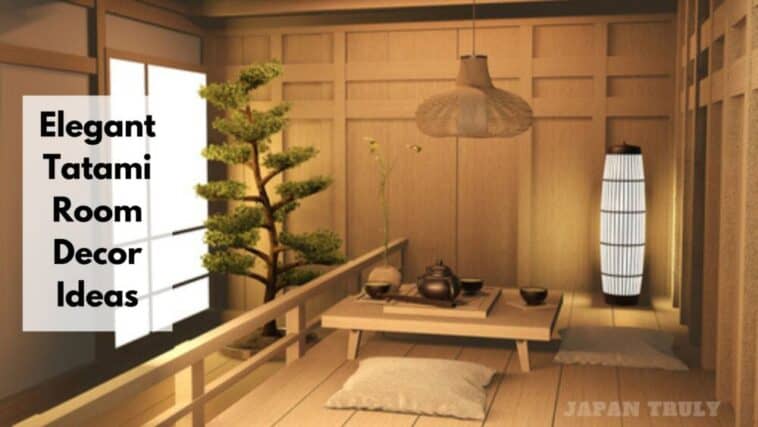Looking for Tatami room design inspiration? We have curated beautiful Tatami room decor ideas and layouts for you to get inspired. Read on to find the ultimate guide to Tatami rooms.
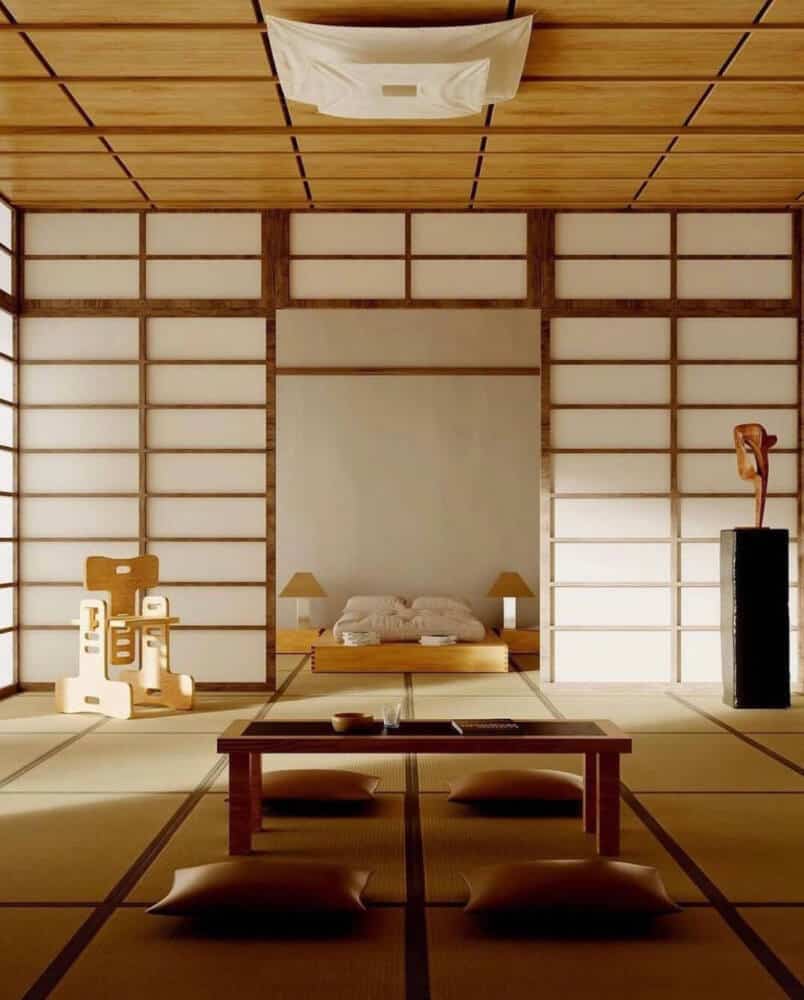
Unleash the tranquility of a tatami room! This guide dives deep into decor ideas that enhance both form and function. Discover inspiring layouts to optimize your space, along with essential design elements to cultivate a calming Japanese-inspired atmosphere.
Page Contents
Tatami Room Decor Ideas
Here are a few examples of how you can arrange your tatami room to create different functional and aesthetic setups:
Traditional Tea Room Set Up In the Tatami Room
- Place a low chabudai (low table) in the center of the room.
- Surround the table with zabuton (floor cushions) for comfortable seating.
- Hang a scroll or artwork in the tokonoma (raised alcove) to add a decorative element.
- Use shoji screens to create a sense of privacy and separation from other areas of the room.
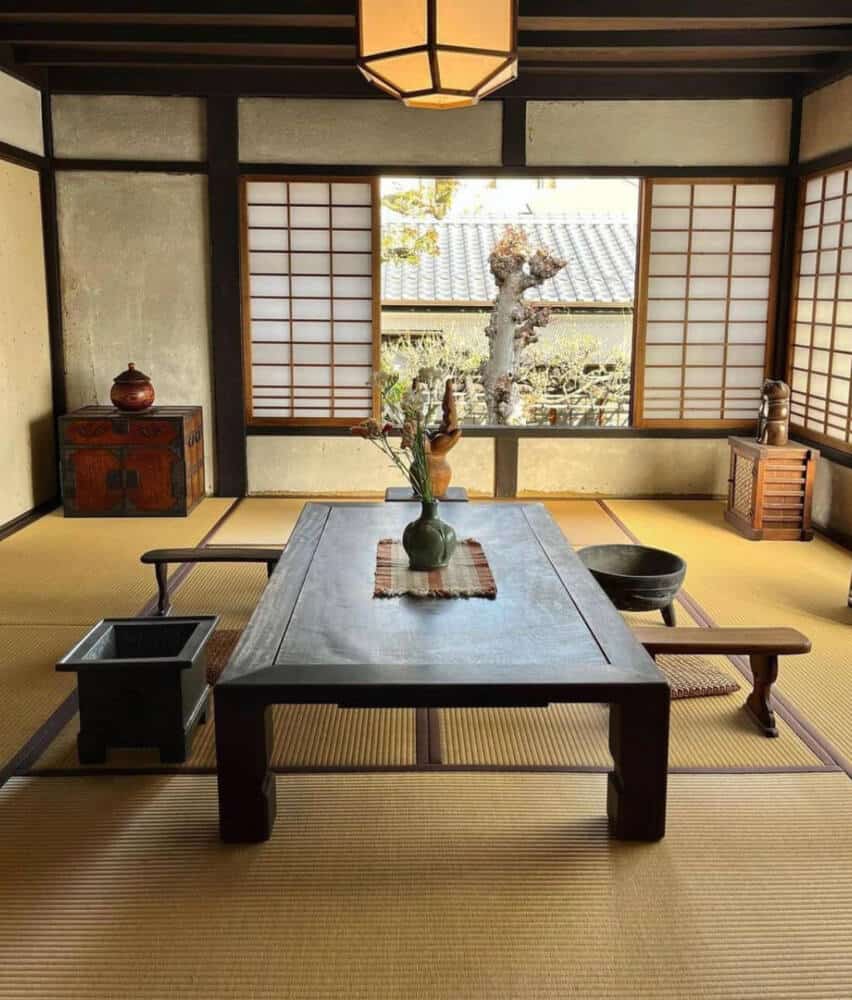
Related: Tatami Room And Its Culture
Meditation Tatami Room
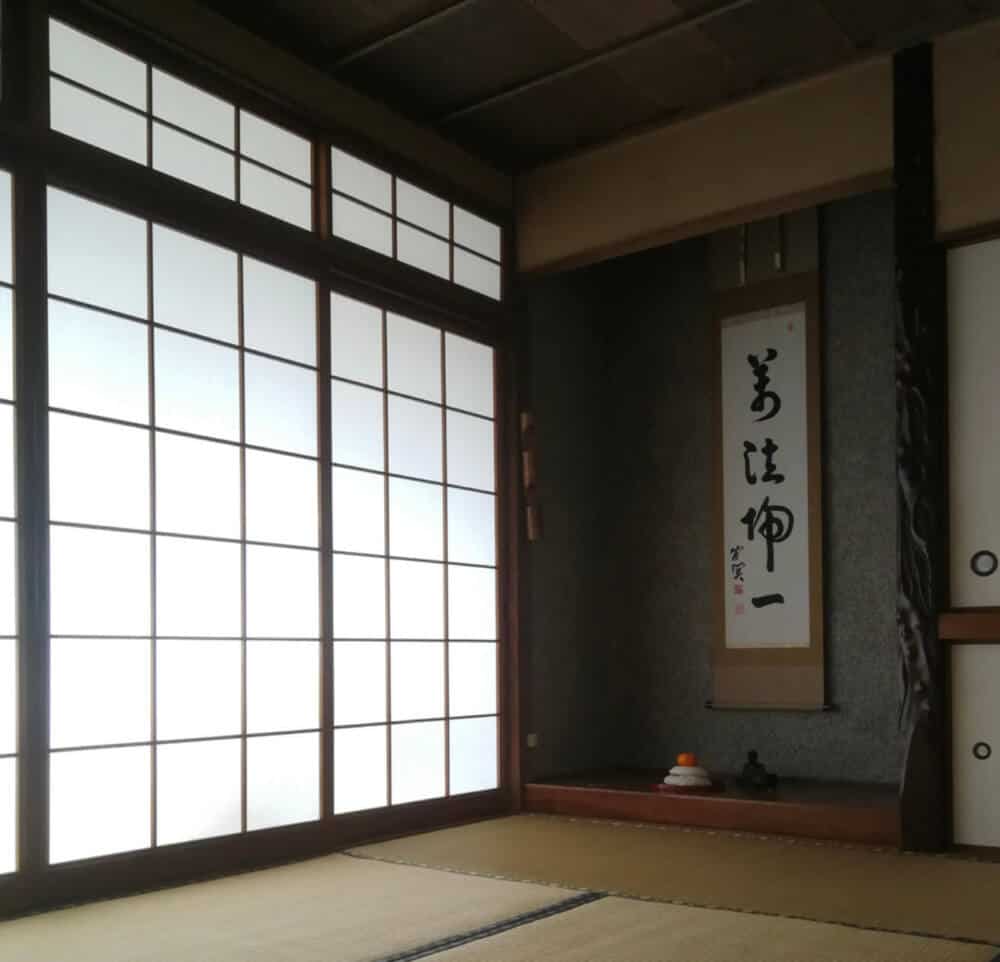
- Clear the room of furniture except for a zabuton or meditation cushion.
- Create a focal point by hanging a peaceful painting or a calligraphy scroll on the wall.
- Use a small incense burner or a Himalayan salt lamp for a calming ambiance.
- Consider adding a small indoor water feature or a Zen garden to enhance tranquility.
Tatami Room Arranged As Multi-Purpose Living Area
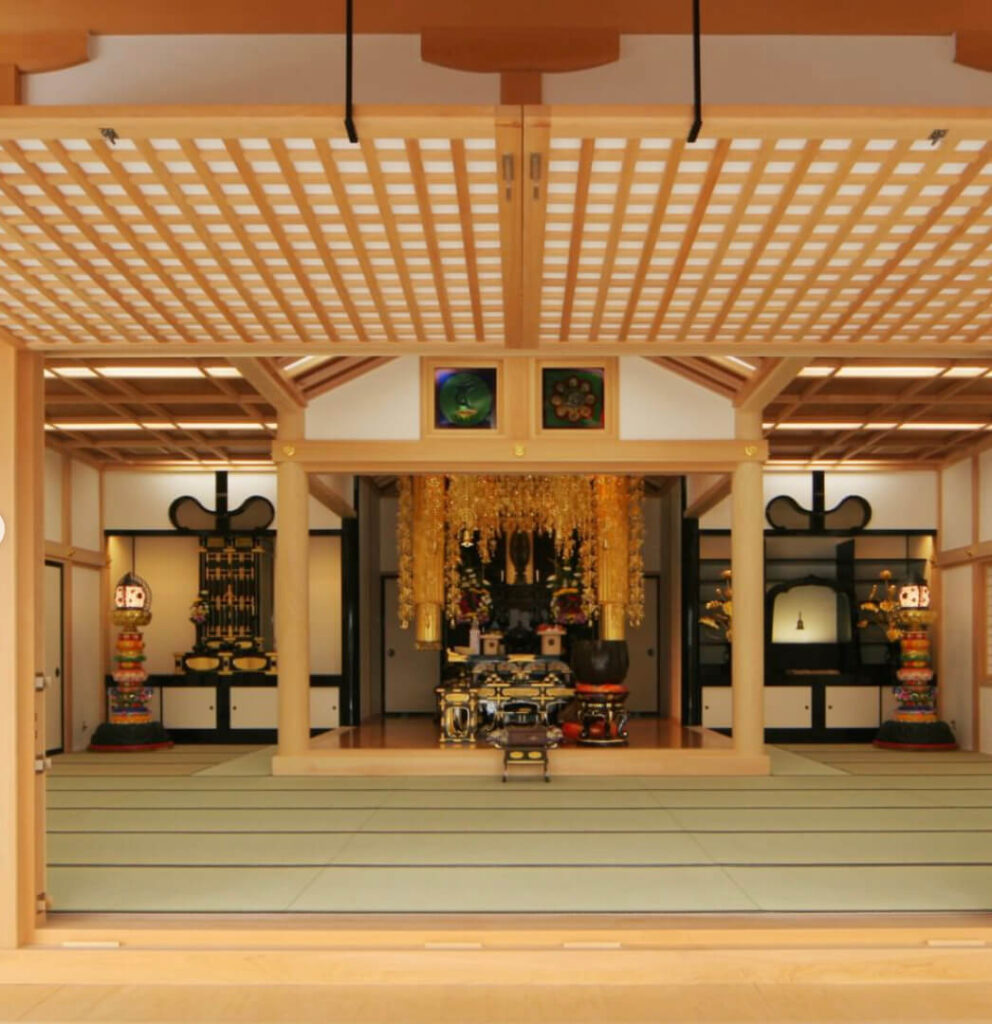
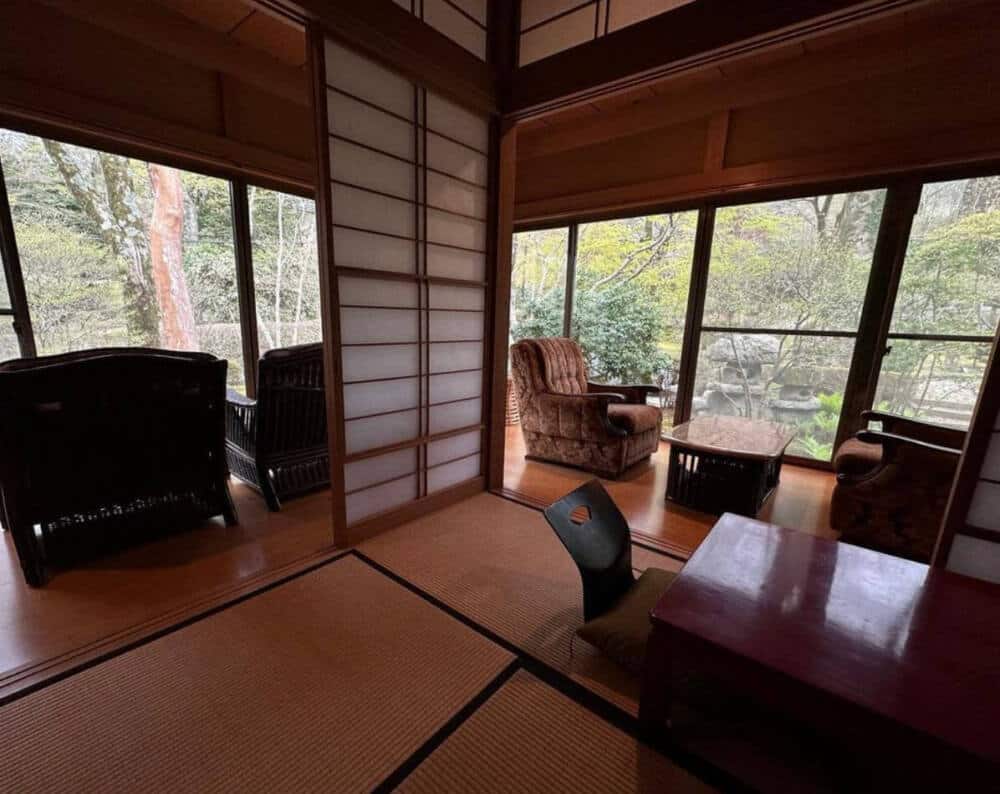
- Place a low chabudai in the center of the room, surrounded by zabuton for dining or gatherings.
- Incorporate a small kotatsu (heated table) for cozy winter evenings.
- Use shoji screens to create distinct zones within the room, such as a seating area or a study corner.
- Include a low bookshelf or wall-mounted shelves for storage and display of books and decor items.
Turn Your Bedroom Into A Tatami Room
- Arrange a futon or shikibuton (traditional Japanese mattress) on the tatami mats for sleeping.
- Use low bedside tables or small chests for storage and to hold personal items.
- Consider adding a room divider or shoji screens to create a separation between the sleeping area and other parts of the room.
- Keep the decor minimalistic, with soft lighting and natural colors for a serene atmosphere.
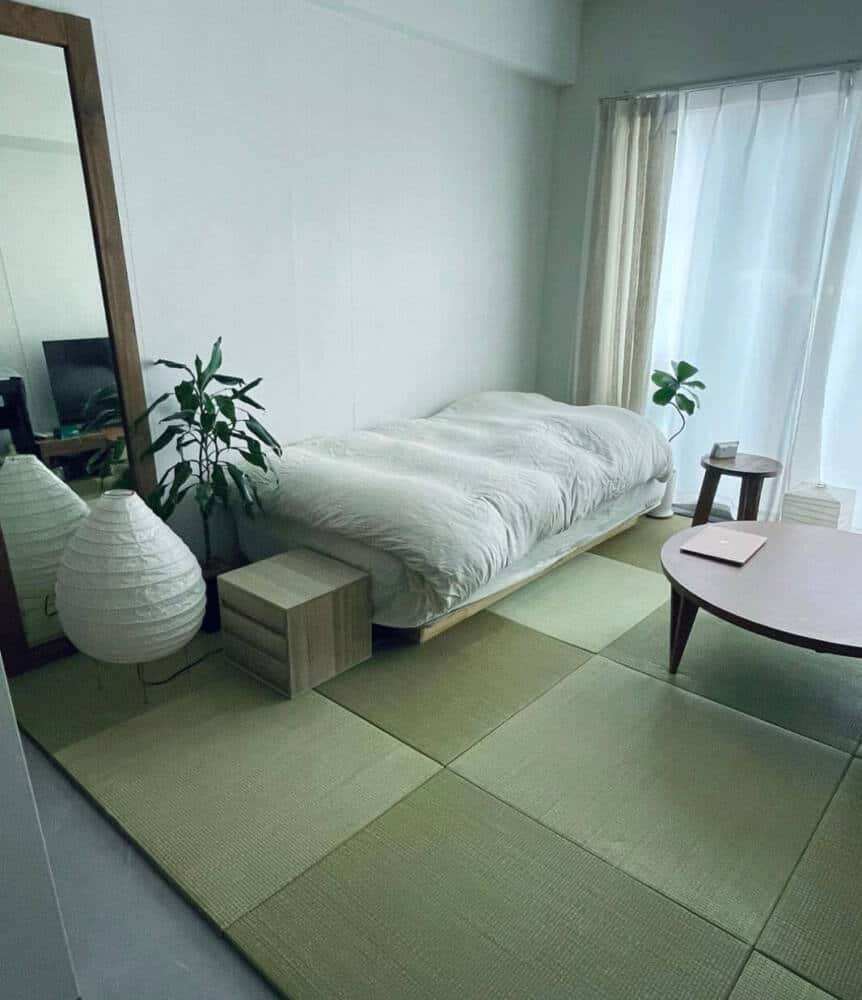
Zen-Inspired Tatami Room
- Place a low chabudai with floor cushions for seating and relaxation.
- Incorporate a small Zen rock garden (karesansui) or a bonsai tree to create a focal point.
- Hang calligraphy scrolls or simple artwork with nature motifs on the walls.
- Use soft, diffused lighting with paper lanterns or floor lamps to enhance the tranquil ambiance.
Home Office Setup:
- Position a low desk or a Japanese-style desk (chabudai with a built-in tabletop) against one wall.
- Use a zabuton or a cushion for seating.
- Place a bookshelf or storage unit nearby to keep office supplies organized.
- Install shoji screens or curtains to separate the workspace from the rest of the room.
A Corner Set In Tatami Style For Reading
- Create a cozy reading corner by placing a comfortable armchair or a floor chair near a window or a well-lit area.
- Use a small side table or a chabudai as a surface for books, a reading lamp, and a cup of tea.
- Arrange a low bookshelf nearby to store your favorite books.
- Add floor cushions or zabuton for extra seating or to stretch out while reading.
Tatami Room For Exercise or Yoga Area:
- Clear a designated space in the room for yoga or exercise.
- Lay down a large tatami mat or multiple tatami mats to create a dedicated workout area.
- Place a mirror on one wall for checking form during exercises.
- Incorporate storage for yoga mats, resistance bands, or other fitness equipment.
Tatami Room That Works As A Kids’ Playroom
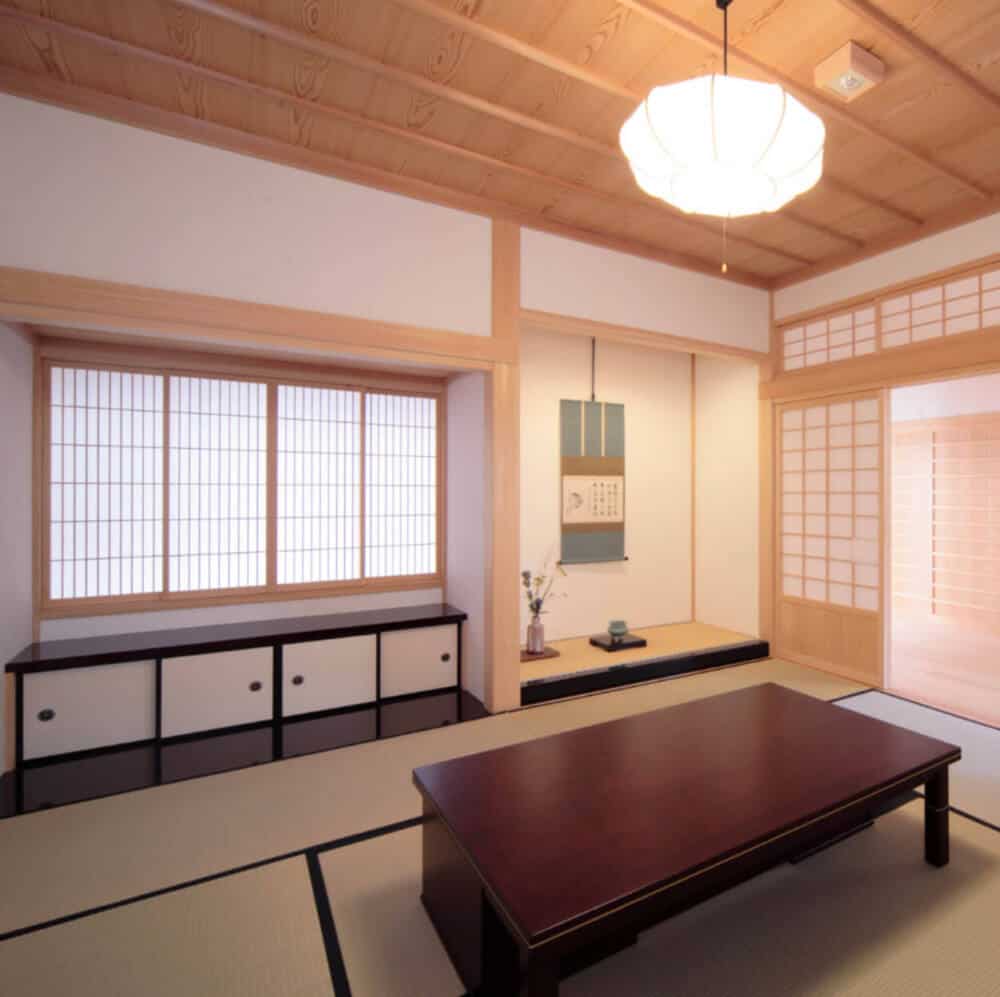
- Arrange a low table or a large tatami mat as a play surface for children.
- Use floor cushions or zabuton for comfortable seating.
- Install shelves or storage units to organize toys, books, and games.
- Add colorful and educational wall decals or artwork to create a playful atmosphere.
Cool Tatami Room That Functions As A Art Studio or Craft Space
- Position a sturdy table or a chabudai as a workspace.
- Use low stools or floor cushions for seating while working on art or craft projects.
- Install wall-mounted storage for art supplies and tools.
- Hang inspirational artwork or a corkboard for pinning ideas and sketches.
Elements Of A Tatami Room

A tatami room, deeply rooted in Japanese tradition, incorporates several essential elements to create a harmonious and serene space. Here are the key elements of a tatami room:
- Tatami Mats
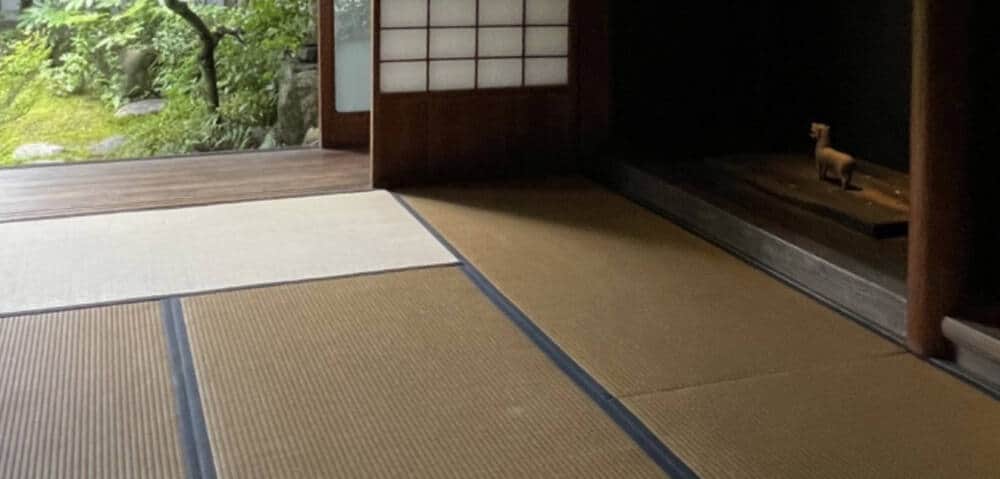
Tatami mats are the foundation of a tatami room. These woven straw mats, typically made from rush grass, provide a comfortable and cushioned surface for sitting, sleeping, and walking. The size and arrangement of tatami mats play a crucial role in determining the layout and proportions of the room.
- Shoji Screens
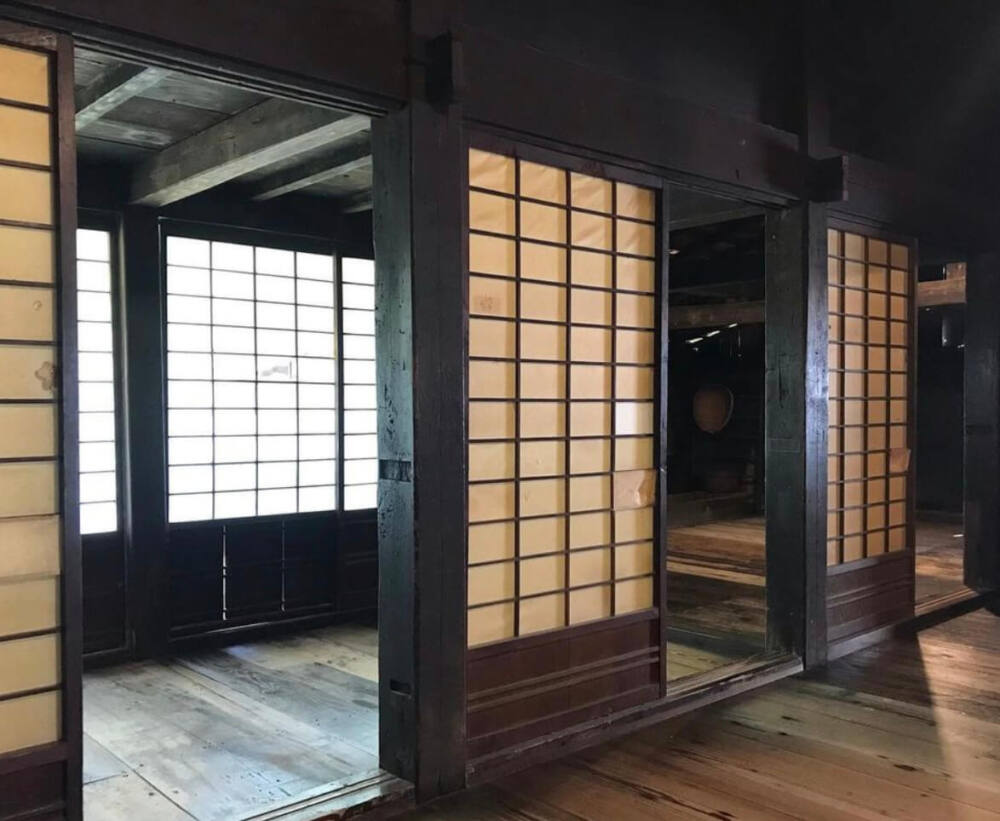
Shoji screens are traditional sliding doors or room dividers made of a wooden frame filled with translucent paper. These screens allow soft, diffused light to filter through, creating a gentle and serene atmosphere. They provide privacy while maintaining a sense of openness and connection to the surroundings.
- Fusuma
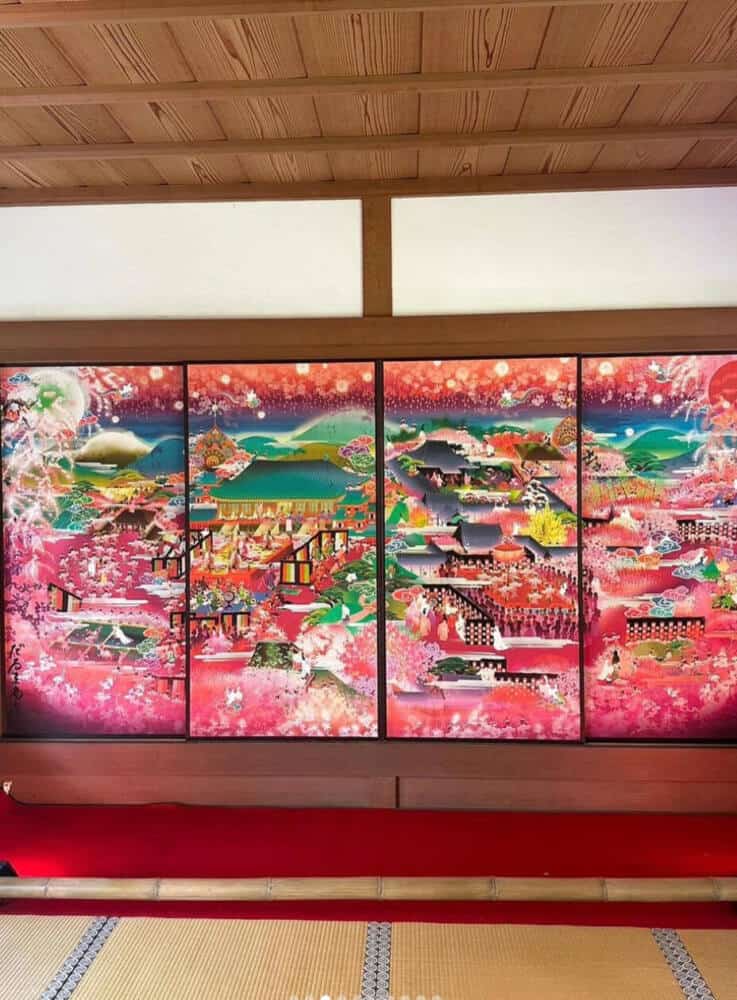
Fusuma are sliding doors with opaque panels that are often painted or decorated with intricate designs. These doors can be used to divide the tatami room into smaller sections or as a decorative element. Fusuma panels often feature traditional Japanese art, landscapes, or symbolic motifs, adding beauty and cultural significance to the room.
- Tokonoma
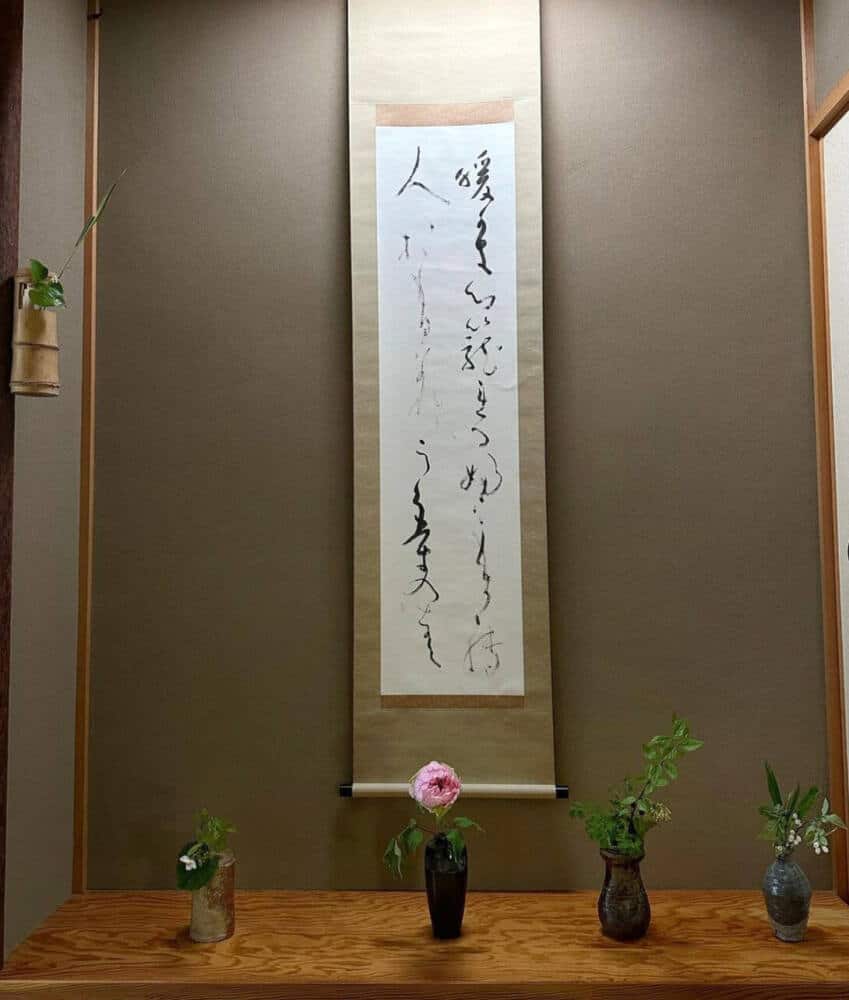
The tokonoma is a raised alcove typically found in traditional Japanese rooms, including tatami rooms. It serves as a space for displaying art, calligraphy scrolls, flower arrangements (ikebana), or other items of aesthetic importance. The tokonoma becomes a focal point, creating a visually pleasing and contemplative area within the room.
- Zabuton and Floor Seating
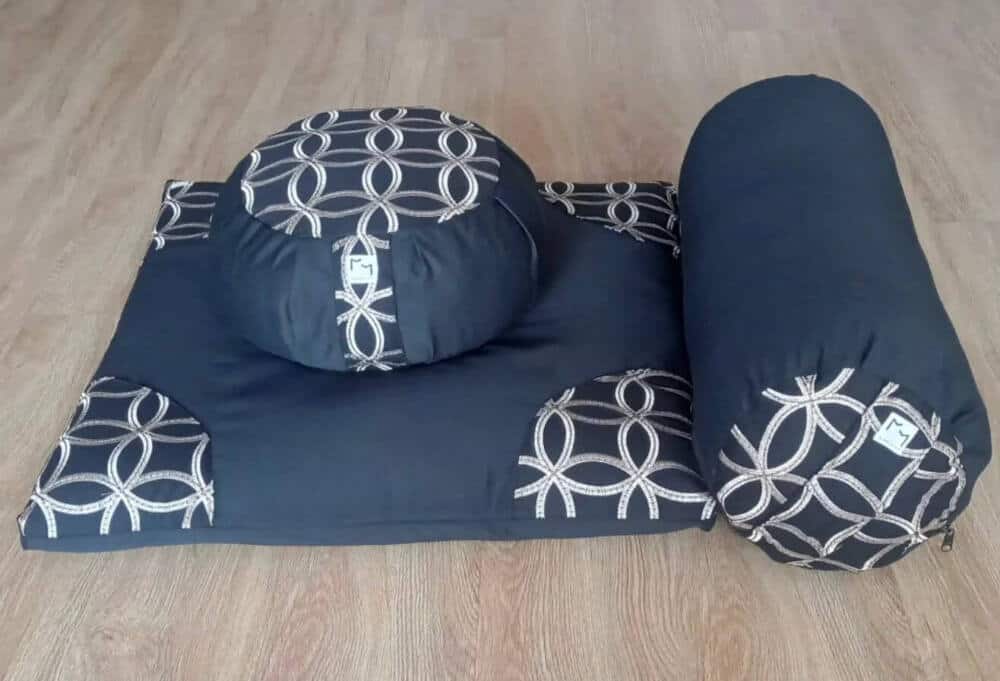
Zabuton refers to traditional Japanese floor cushions that provide comfortable seating in a tatami room. Floor seating is an integral part of the tatami experience, allowing for a close connection with the floor and facilitating a relaxed and informal atmosphere.
- Natural Materials
Tatami rooms often emphasize the use of natural materials. From the tatami mats themselves to wooden frames, bamboo, rice paper, and natural fabrics, the incorporation of these elements brings a sense of harmony with nature and a tactile warmth to the space.
- Simple and Minimalist Design
Tatami rooms embrace the concept of simplicity and minimalism. The design focuses on clean lines, uncluttered spaces, and a balanced arrangement of furniture and decor. By minimizing distractions and unnecessary ornamentation, the room encourages a sense of calm and clarity.
- Engaging with Nature
Tatami rooms often seek to create a connection with the natural world. This can be achieved through the incorporation of elements like indoor plants, bonsai trees, bamboo accents, or a small rock garden (karesansui). These elements bring a sense of serenity and the outdoors into the room.
- Ambient Lighting
Tatami rooms typically feature soft and ambient lighting. Paper lanterns, floor lamps with warm-toned bulbs, or recessed lighting can be used to create a gentle and soothing illumination. The aim is to evoke a peaceful and relaxed atmosphere.
- Harmony and Proportion
The most crucial element of a tatami room is the pursuit of harmony and proportion in every aspect of the design. From the layout of tatami mats to the placement of furniture, decor, and artwork, every element is carefully considered to create a balanced and serene space.
By incorporating these elements, you can create an authentic tatami room that embodies the elegance, simplicity, and tranquility of traditional Japanese design.
How to decorate a Tatami room?
Decorating a tatami room requires a mindful approach that embraces the principles of simplicity, balance, and harmony. Here are some tips to help you decorate a tatami room:
- Take the Minimalistic Approach
Start with a minimalist mindset. Keep the room uncluttered and select only essential furniture and decor items. Embrace clean lines, simplicity, and functionality in your choices.
- Choose Tatami Mats
The tatami mats themselves serve as a significant decorative element. Choose high-quality mats made of rush grass that exude a natural and earthy feel. Consider covering the entire floor with tatami mats or strategically placing them to create designated areas within the room.
- Use Shoji Screens
Incorporate shoji screens, traditional sliding doors made of translucent paper and wooden frames. These screens not only add an elegant touch but also diffuse soft light, creating a peaceful ambiance. Use them to divide the space or as decorative features.
- Use Natural Colors and Materials
Opt for a color palette inspired by nature, such as soft greens, browns, and neutrals. Use natural materials like wood, bamboo, rice paper, and textiles made from natural fibers to create a sense of harmony with the surroundings.
- Choose the right Furniture
Choose furniture pieces that are simple, functional, and low to the ground. Traditional Japanese furniture, like low tables (chabudai) and floor cushions (zabuton), work well in a tatami room. Consider incorporating storage solutions like wooden chests or wall-mounted shelves to keep the space organized.
- Zen-Inspired Decor
Draw inspiration from Zen aesthetics to create a calm and contemplative atmosphere. Incorporate elements like bonsai trees, ikebana flower arrangements, or calligraphy art. Choose decor pieces that are minimal and carefully selected, evoking a sense of tranquility and mindfulness.
- Engaging the Senses
Create a sensory experience in the room. Use soft lighting with warm-toned bulbs, paper lanterns, or floor lamps to create a soothing ambiance. Incorporate natural scents through candles or diffusers with fragrances like sandalwood or green tea. Consider adding gentle sounds, such as wind chimes or a small indoor water feature, to create a serene soundscape.
- Harmonious Layout
Arrange furniture and decor items in a balanced and proportional manner. Avoid cluttering the space and maintain an open flow. Pay attention to the placement of larger furniture pieces and ensure they do not overwhelm the room’s proportions.
- Cultural Touches
Infuse the room with cultural elements that resonate with the Japanese aesthetic. Consider incorporating traditional artwork, decorative fans, or symbolic items like a miniature Zen rock garden or a bamboo water fountain.
- Personalization
While adhering to the principles of tatami room decor, make the space your own. Add personal touches like family photos displayed in simple frames or small mementos that hold sentimental value. Remember to maintain a sense of simplicity and moderation in personalization.
Remember, the essence of decorating a tatami room lies in creating a serene, balanced, and harmonious environment that encourages relaxation and mindfulness. By embracing simplicity, natural elements, and a mindful approach, you can curate a space that embodies the timeless elegance of Japanese tradition.
What furniture can you put on Tatami?
When it comes to furnishing a tatami room, it’s essential to select furniture pieces that complement the traditional Japanese aesthetic and maintain the integrity of the space. Here are some furniture options that work well in a tatami room:
- Low Tables (Chabudai)
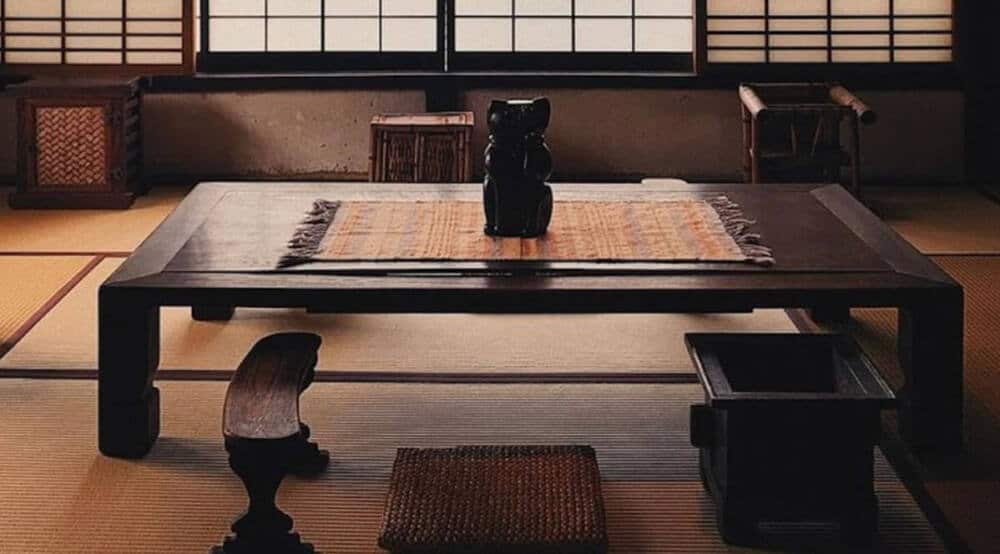
Low tables are a staple in Japanese homes and are perfect for a tatami room. Choose a chabudai made of natural materials like wood and keep it simple and minimalistic in design. This table can be used for tea ceremonies, dining, or as a general gathering space.
- Floor Cushions (Zabuton)
Zabuton are traditional Japanese floor cushions that provide comfortable seating. They can be placed around the low table or used independently for meditation or relaxation. Select zabuton that are made with durable, high-quality fabric and stuffed with soft materials for optimal comfort.
- Japanese-Style Chairs
If you prefer a seating option with back support, opt for Japanese-style chairs that are designed to be closer to the ground. These chairs typically have a minimalistic design, often with a wooden frame and a low, cushioned seat.
- Futon or Shikibuton
A tatami room can also serve as a guest room by incorporating a futon or shikibuton. These traditional Japanese mattresses can be placed directly on the tatami mats for sleeping. When not in use, they can be rolled up and stored away, allowing the room to be used for other purposes.
- Shelves and Storage
Incorporate wooden shelves or wall-mounted storage units to keep the room organized and minimize clutter. Choose designs that are simple and blend well with the overall aesthetic. These storage options can be used to display decor items, store books, or keep personal belongings neatly arranged.
- Kotatsu
A kotatsu is a low, heated table that is popular in Japan during the colder months. It consists of a table frame with a blanket or futon draped over it, along with a heat source underneath. This cozy setup is perfect for staying warm and comfortable while enjoying a cup of tea or engaging in activities during winter.
- Decorative Accents
Consider incorporating traditional Japanese decorative accents like a hanging scroll (kakemono), bonsai tree, or a small bamboo water fountain. These accents add a touch of cultural authenticity to the room and enhance the overall ambiance.
Remember, when placing furniture on tatami mats, it’s important to be mindful of their delicate nature. Avoid heavy furniture that may damage or leave permanent marks on the mats. Additionally, furniture with legs that can potentially damage the tatami can be protected by placing soft pads underneath them.
By selecting furniture pieces that align with the Japanese aesthetic, you can create a harmonious and functional tatami room that preserves the traditional charm and tranquility of the space.
Benefits Of Using Tatami Mats
Using tatami mats in your living space offers several benefits that contribute to a comfortable, healthy, and harmonious environment. Here are some key benefits of using tatami mats:
Natural and Eco-Friendly: Tatami mats are made from natural materials such as rush grass, which is woven together to create a sturdy and durable surface. By opting for tatami mats, you promote a more sustainable and eco-friendly lifestyle by using renewable resources.
Comfort and Cushioning: Tatami mats provide a soft yet supportive surface to walk, sit, or lie on. The natural materials used in their construction offer a slight cushioning effect, reducing pressure on the body’s joints and providing a comfortable experience. This makes tatami mats especially beneficial for activities like meditation, yoga, or sitting for extended periods.
Temperature and Moisture Regulation: Tatami mats have excellent insulation properties. They help regulate the temperature in a room by providing insulation against cold floors during winter and maintaining a cool environment in hot weather. Tatami mats also have moisture-absorbing qualities that can help regulate humidity levels, contributing to a healthier indoor climate.
Allergen Reduction: Unlike carpets, which can accumulate dust, allergens, and mites, tatami mats are less prone to trapping allergens. Their woven surface allows for better air circulation, reducing the likelihood of dust accumulation and creating a healthier living space, particularly for individuals with allergies or sensitivities.
Natural Fragrance: Tatami mats have a distinctive earthy scent due to the use of rush grass. This natural fragrance can help create a calming and soothing atmosphere in the room, enhancing relaxation and promoting a sense of well-being.
Versatility and Adaptability: Tatami mats offer versatility in terms of design and arrangement. They can be easily rearranged or removed to create different configurations within a space, making them suitable for multi-purpose rooms or areas that require flexibility.
Aesthetic Appeal: Tatami mats add a touch of elegance and traditional Japanese aesthetics to any room. Their clean and minimalistic appearance can enhance the overall visual appeal of the space, creating a serene and harmonious ambiance.
Acoustic Benefits: Tatami mats help absorb and dampen sound, reducing echo and reverberation within a room. This can contribute to a quieter and more peaceful environment, making them suitable for meditation spaces or areas where noise reduction is desired.
Connection to Japanese Culture: Incorporating tatami mats in your living space allows you to embrace and appreciate the rich cultural heritage of Japan. It adds a unique and authentic touch to your home, creating a sense of connection and appreciation for traditional Japanese design and lifestyle.
By utilizing tatami mats in your living space, you can enjoy the numerous benefits they offer, ranging from comfort and aesthetics to health and sustainability. Their natural properties and cultural significance contribute to a well-rounded and enriching living experience.
Can you give me some examples of how I can arrange my tatami room
What Are Tatami Mats?
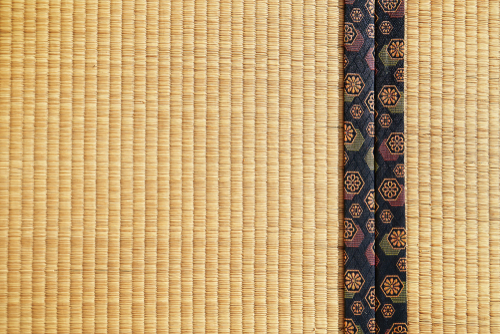
Tatami Mats are traditional straw mats that measure only about one by two meters in size. This mat was originally used only by the well-to-do people before it gradually became the most common household item in every Japanese home. Japanese tatami mats are extremely integral to Japanese home and history.
History of Tatami Mats
Tatami Mats was first mentioned in the oldest Japanese book which is the record of ancient matters. This goes far back to 712. Tatami Mats were originally quite thin and could easily be folded or piled up.
Throughout Japanese history, we can see that the floors in Japan would be made of wood and tatami Mats were used for the purpose of seating. These were originally used in the houses of well-to-do people.
Over the centuries, the use of tatami Mats has expanded. Japanese-style rooms in the Edo period used these Tatami mats quite commonly. These mats were used by nobles and Samurai to sleep on. Common people, on the other hand, used straw mats or even loose straws for bedding.
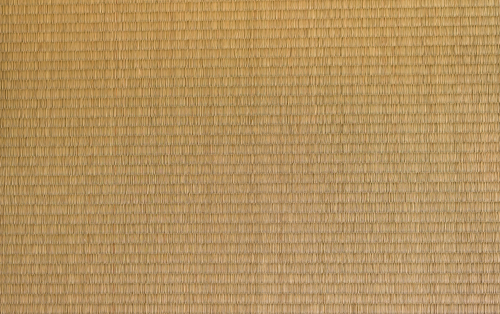
Tatami Mats were then used to cover the entire floor of a room. These areas were called Zashiki and the arrangement of tatami Mats in the room was determined by strict rules.
Then in the 16th century, the ritual of the Japanese tea ceremony started happening in small tea rooms. These tea rooms contained natural materials including tatami mat flooring.
By the end of the 17th-century, tatami mats became an extremely popular way of making the floors in most Japanese homes. This tradition is being followed even today.
Most Japanese houses, including modern city apartments, contain tatami mat rooms. Japanese people often prefer to sleep on the tatami mat with the futon on top. I would highly recommend that you experience sleeping on a tatami mat at least once in your life when you visit Japan.
How Big Are Tatami Mats?
Tatami Mats are extremely popular and widespread in Japan. Using these mats is the most preferred way of adding flooring to homes in the country. Since it has been a huge part of Japanese history, tatami mats came to be the standard unit for determining room size.
In Japan, Jo is used for measuring the size of a room. This is done by calculating the number of tatami mats that will fit inside it.
How Are Tatami Mats Laid Out?
There are several rules concerning the arrangement of tatami mats and the number used. During the Edo period, tatami layouts were distinguished. Depending on the occasion, you could easily rearrange the mats.
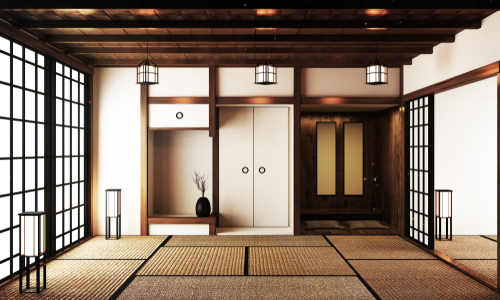
Nowadays, however, it is believed that if the tatami junctions form a cross, it will bring bad fortune. Even using evenly patterned grids is considered to be inauspicious. The only exception in which you can use a grid pattern is when you are mourning.
The auspicious tatami arrangement today is one where no four corners of any full-size mat touch. The main aim here is to ensure that the junctions of the Mats form a T-shape that will bring in good fortune.
How Are Tatami Mats Made?
Tatami mat has a very simple and basic structure and it consists of a base, a cover, and a border.
Base
The base of tatami mats is usually made using multi-layered natural rice straw. The straw is tightly attached and compressed. Using a natural base is the best choice for the mat. This makes it a very economical option in the long term and it has also been used for centuries.
The key features of tatami’s natural base include durability, fireproof properties, humidity control, resilience, and thermal insulation.
The feeling of walking on a tatami mat, therefore, is extremely unique. The base of mats is based on various grades. If you use more natural materials, it helps to determine the cost and quality.
As the grades of the base differ, the straw that is included in the base also differs. The best quality base is used in shrines, tea rooms, and temples. The multipurpose base is most common for apartments.
Today, styrofoam is also used to make the base of the tatami mats. For this purpose, it is inserted between compressed wood chipboard. Using styrofoam or other light materials gives a feeling that is similar to the natural base. However, it definitely does make it harder and less durable. But there are also several advantages to it. Using light materials makes the base cheaper, lighter, better insulated, and more resistant to moisture and bugs.
Cover
The cover is made using a woven natural soft rush straw. The highest grade of cover is used in shrines, temples, and other important places. A high-quality cover usually has four strings two at each weave. These are used to bind the straw together.
The stronger the string, the thicker the surface. This also affects the feeling on the foot. The rush straw that is used to make the cover in the mats is only harvested once a year. In Japanese and international homes, high to mid grades are used. Outside of Japan, you will be able to find cheaper mats.
New Tatami flooring usually has a light green color and it smells like fresh grass. This scent goes away in a few weeks. The color of the tatami flooring also gradually changes into light brown with age. The color then starts to match the wooden interiors inside.
Tatami Mats are perfect when we look at the climate of Japan. It is humid and hot in summer and dry and cold in winter. Tatami flooring helps to increase the quality of life you are living. These mats provide sound and temperature insulation and also filter the air in the room and absorb carbon dioxide.
Border
Tatami mats borders were used to be made of cotton or hemp. Today, synthetic borders are used because they are cheaper and stronger. However, if you look at the quality, nothing is better than natural fiber. High-class borders are made using hemp. You will also find that the border was made using silk brocade in the house of wealthy owners.
The borders could be solid or have additional Japanese patterns. These are most often used in temples and alcoves. Since tatami borders are durable and beautiful, the fabric used here could also be used in products like bags and pouches.
How To Take Care of a Tatami Mat?
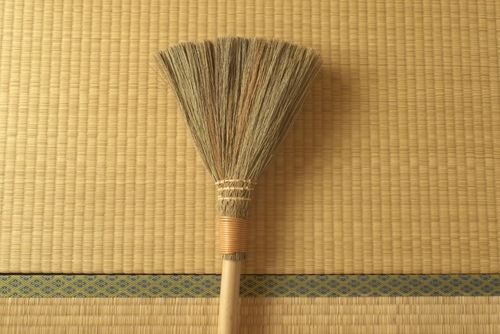
The easiest way that you can use to clean tatami mats is by using a vacuum cleaner. You need to vacuum along the grain or else you will end up damaging the cover. After vacuuming, you can also wipe the surface along the grain using a dry cotton cloth.
Never use a wet cloth to clean your tatami mat. It are known to retain moisture and using a wet cloth can cause mold to grow. A wet cloth can also eliminate some of the natural surface oils that are there to protect the mat from aging too rapidly.
It is also important that you place your mat in a well-ventilated room. Ensure that you often open the windows or use a fan to circulate air. You may place the furniture for long periods on the tatami floor; this will not change the shape as the tatami will resume its original shape once you remove the furniture.
Tatami Mats can also be renewed if the old rush flooring needs to be replaced. This process is usually known as ‘change of Tatami cover’. You can follow this procedure at a tatami repair shop.
How To Use Tatami Mats?
Japanese people still enjoy a tatami floor because it is highly comfortable. The mats are nowadays placed on wooden floors. This has become extremely common.
If you want to add a slight Japanese touch to your Western and modern room, simply add tatami mats and enjoy the feel of a traditional Japanese home.
Tatami is now available in several different forms such as tatami yoga mats, tatami play rugs, miniature tatami mats, foldable ones, and even tatami shoe soles.
The beauty of Tatami Mats!
I hope this guide helped you understand the importance of tatami mats in Japanese history and culture. It’s extremely popular throughout the country even today. The experience that you get on tatami mats is unmatched by any.
If you are in Japan, I would highly recommend that you experience tatami flooring at least once. You can also get tatami mats for your apartment even if you’re not in Japan.


